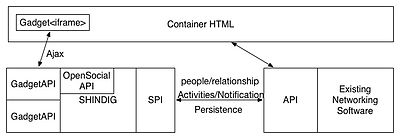OpenSocial
It has since evolved into a runtime environment that allows third-party components, regardless of their trust level, to operate within an existing web application.
Since its inception on November 1, 2007,[1] applications that implement the OpenSocial APIs can interoperate with any social network system that supports them.
This language facilitates tag-based access to data from the OpenSocial APIs, which previously necessitated an asynchronous client-side request.
[7] OpenSocial was rumored to be part of a larger social networking initiative by Google code-named "Maka-Maka",[8] [9]which is defined as meaning an "intimate friend with whom one is in terms of receiving and giving freely" in Hawaiian.
[10] An open-source project, Shindig, was launched in December 2007 to provide a reference implementation of the OpenSocial standards.
Apache Rave is a lightweight and open-standards-based extensible platform for using, integrating, and hosting OpenSocial and W3C Widget-related features technologies, and services.
On December 6, TechCrunch followed up with a report by MediaPops founder Russ Whitman, who said, "While [they] were initially very excited, [they] have learned the hard way just how limited the release truly is."
Russ added that "core functionality components" are missing and that "write once, distribute broadly" was not accurate.
[19] Legend: Discontinued Current Changes to the REST API were made to address several issues that required changes in the OpenSocial specifications so the Open Mobile Alliance could use it..[20] Common Containers were added that provided "a set of common services that Container developers can leverage for features like in-browser Gadget lifecycle event callbacks, Embedded Experiences, selection handlers, and action handlers.
OpenSocial acknowledged that the "one-size-fits-all" approach it was taking was not going to work for the diverse types of websites that had adopted the platform.
[2] This allowed a developer to pick and choose the modules they wanted to use while using other services that aren't part of OpenSocial.
OpenSocial Templates were introduced to create data-driven UI with a separation of markup and programmatic logic.
This minor release placed a major focus on server-to-server protocols as "the Person schema has been aligned with the Portable Contacts effort, and an optional RPC proposal has been added.
The RESTful protocol that was introduced in v0.8.0 underwent a large revision with several fields being added, modified, and deleted.
Security improved with the introduction of OAuth authorization and HTML sanitation, and container lifecycle events.
"[28] It added several standard fields for profile information, the ability to send a message to install an application, an Activity template to control activity notifications about what users have been doing, and a simplified persistence API to use feeds instead of global and instance-scoped application data.
While unstable, this API introduced "various XML DTDs, Javascript interfaces and other data structures"[30] to the OpenSocial platform.
